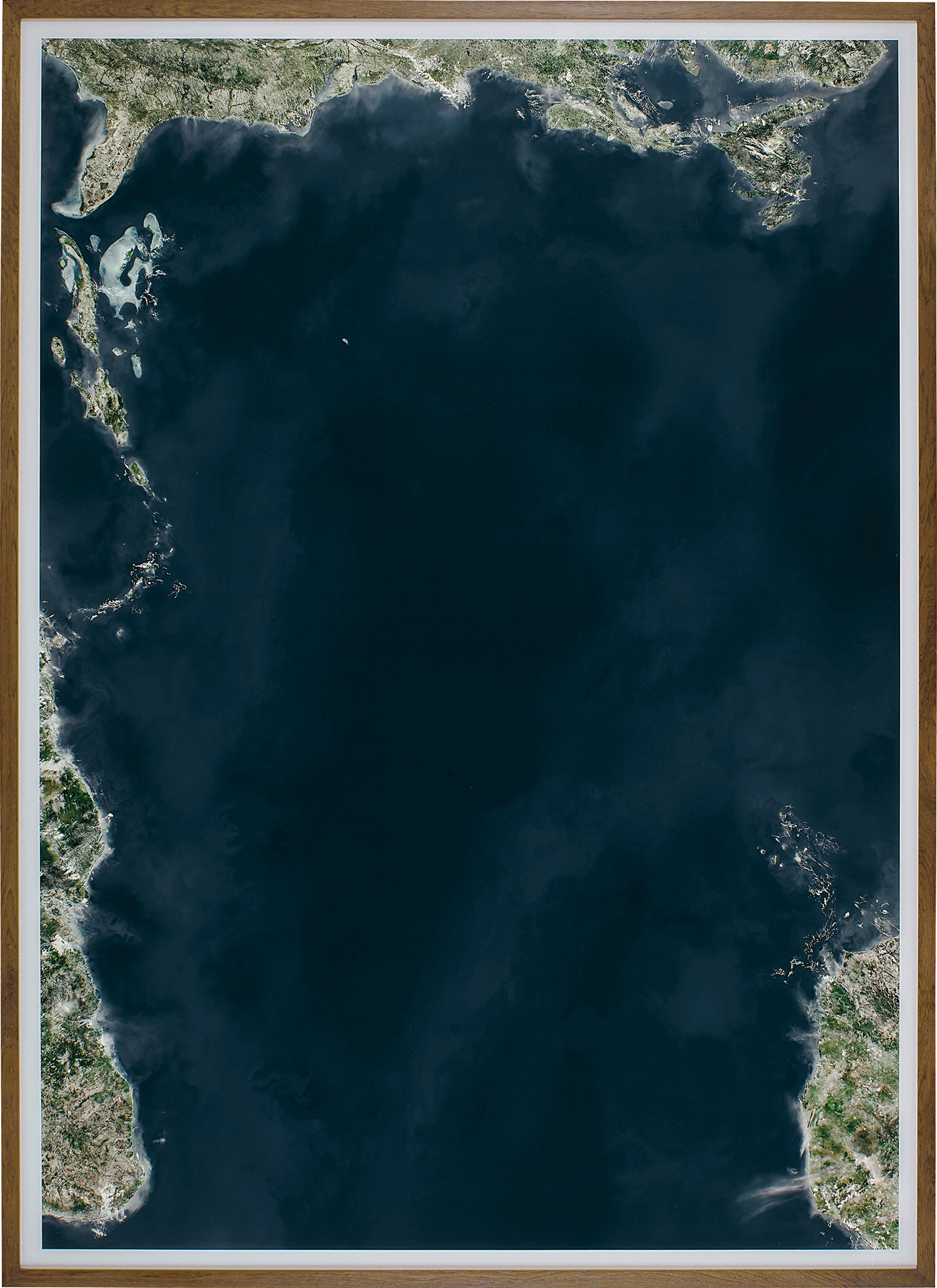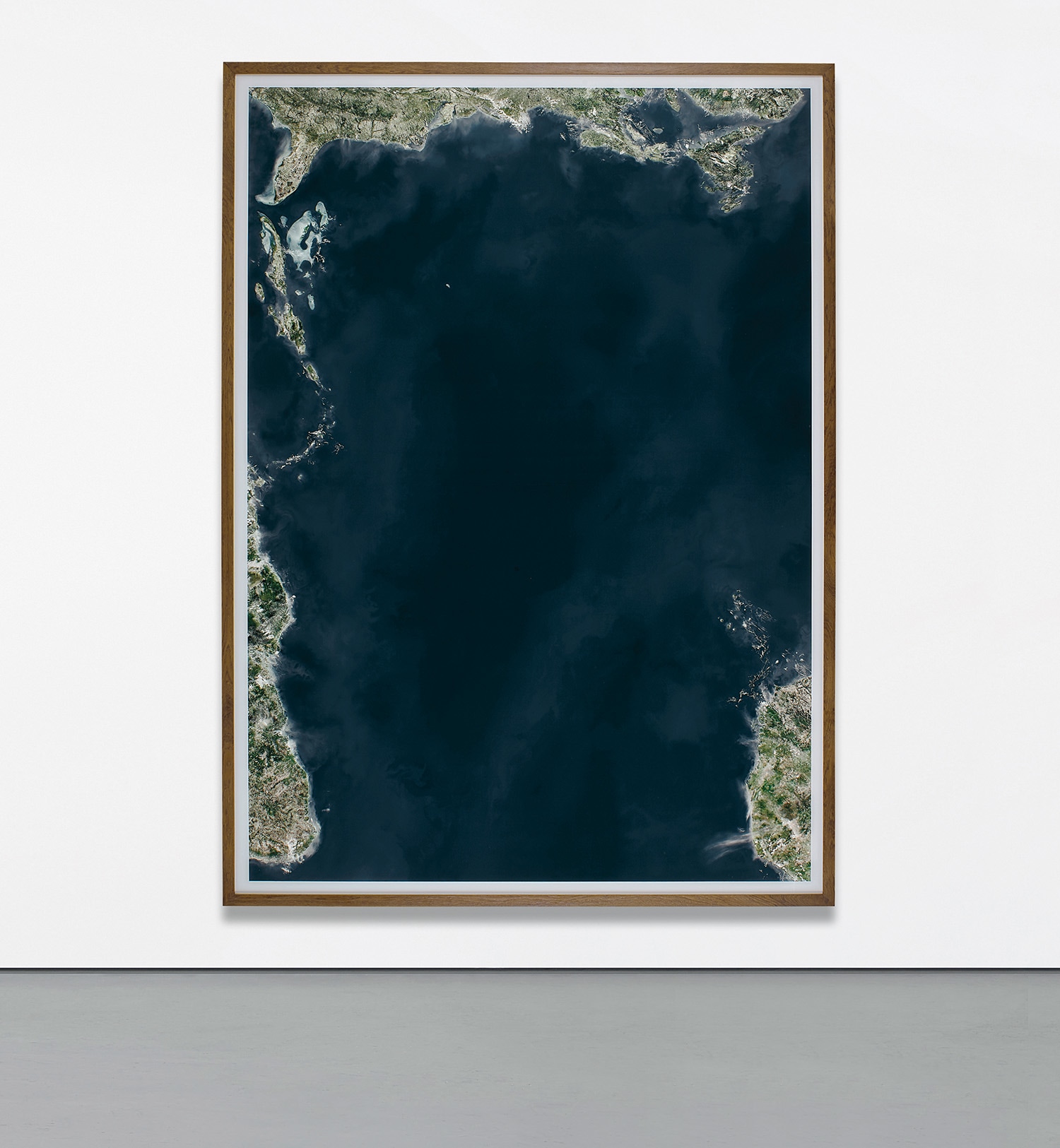



174
Andreas Gursky
Ocean VI
signed 'Andreas Gursky' on a label affixed to the reverse
c-print, in artist's frame
341.4 x 249.6 cm (134 3/8 x 98 1/4 in.)
Conceived in 2010 and printed in 2012, this work is number 1 from an edition of 6.
Full-Cataloguing
Belonging to Andreas Gursky’s six-picture Ocean series, the present work, Ocean VI, showcases the artist’s advancements in the evolution of photography, demonstrating his adept exploration of the medium’s capabilities on a magnificent scale. Conceived in 2010 and printed in 2012, Gursky embarked on this progressive body of work after boarding a flight from Dubai to Melbourne where, as the plane flew over the Indian Ocean, Gursky watched the on board cartographical map slowly alter with the plane’s flight path. Presenting new, ever-developing perspectives, the screen mapped the coastlines of countries which slowly edged into view, swathes of computerised black sea programmed in between. Using panoramic satellite imagery of coastal landmasses, the artist meticulously stitched together each shot, creating a complex composite of land and fastidiously-crafted sea. The sixth installment of the series, the present work belongs to the artist’s arguably most experimental body of work; in Ocean VI Gursky has pushed the boundaries of photography to its limits to create the ultimate aerial perspective from the highest viewpoint, resulting in an exquisitely rendered compositional balance.
Transporting the viewer to an elevated vantage point, a god-like view ordinarily inaccessible to us, the present work presents us with the impossible. In Ocean VI, we are suspended in a heavenly intermission, where we are afforded a rich perspective over the world we inhabit. The landscape depicted in Ocean VI also defies space and time; in a single glance it would not be feasible to observe the vast expanses of ocean and land that Gursky presents. Instead the artist splices, edits and shifts the composition, emphasising abstract elements and flattening the plane. Celebrated in the Ocean series, and characteristic of his practice, Gursky’s images offer an absence of hierarchy, where all details are balanced in a carefully crafted equilibrium of space, form, colour and distance, inviting our eye to rove over his expansive microcosms to discover new areas of intrigue. Imbuing fields of negative space and a reduction of compositional elements, André Rottmann has compared Gursky’s Ocean series to the Colour Field canvasses of Morris Louis; this abstraction is evident in both Ocean VI and Louis’ Unfurleds (1960-1961), where pure colour flows across the edges of the raw canvas (Brian Sholis, ‘The Order of Things’ in Andreas Gursky, exh. cat., Hayward Gallery, London, 2018, p. 151). In the present work, land borders the composition with the swell of sea subsuming large areas of the image. The landscape feels boundless as if we are seeing a momentary snapshot of an edited view, only a small fraction of the full reality, which in turn emphasises the enormity of the world beneath us.
In the manner of Alexander von Humboldt’s 1802 realisation, whilst sitting atop the Chimborazo mountain in Ecuador, that the world beneath him was composed of both small and fundamental connections, an interwoven web of organic actions and consequences, so Gursky’s monumental photograph invites us to meditatively contemplate our existence on earth. Through this direct confrontation of elemental power, the viewer is forced to examine their place within nature, faced with the power of the ocean, swell of the waves, vast archipelagos and wild coastlines. Presenting us with the vitality of the elements, no humans feature in his Ocean composition. As Gursky states, ‘I am never interested in the individual, but in the human species and its environment’, (the artist, quoted in Brian Sholis, ‘The Order of Things’ in Andreas Gursky, exh. cat., Hayward Gallery, London, 2018, p. 149). In the present work, Gursky explores the cartographical confines of the sea, highlighting the importance of water to our very existence. Shaping our land borders, our topography is defined by the division of the landscape following the rivers and inlets which flow and wind like arteries, creating bountiful hubs and plentiful ports for trade. At the centre and beginning of our very existence, the ocean spans the centre of the composition, it’s sheer depth and resonance transfigured in two dimensions. As Brian Sholis remarks, ‘...the central placement of large, watery expanses serves as a clue. Their dusky surfaces seem placid, but beneath them, of course are teeming depths’. (Brian Sholis, ‘The Order of Things’ in Andreas Gursky, exh. cat., Hayward Gallery, London, 2018, p. 151).
Transporting the viewer to an elevated vantage point, a god-like view ordinarily inaccessible to us, the present work presents us with the impossible. In Ocean VI, we are suspended in a heavenly intermission, where we are afforded a rich perspective over the world we inhabit. The landscape depicted in Ocean VI also defies space and time; in a single glance it would not be feasible to observe the vast expanses of ocean and land that Gursky presents. Instead the artist splices, edits and shifts the composition, emphasising abstract elements and flattening the plane. Celebrated in the Ocean series, and characteristic of his practice, Gursky’s images offer an absence of hierarchy, where all details are balanced in a carefully crafted equilibrium of space, form, colour and distance, inviting our eye to rove over his expansive microcosms to discover new areas of intrigue. Imbuing fields of negative space and a reduction of compositional elements, André Rottmann has compared Gursky’s Ocean series to the Colour Field canvasses of Morris Louis; this abstraction is evident in both Ocean VI and Louis’ Unfurleds (1960-1961), where pure colour flows across the edges of the raw canvas (Brian Sholis, ‘The Order of Things’ in Andreas Gursky, exh. cat., Hayward Gallery, London, 2018, p. 151). In the present work, land borders the composition with the swell of sea subsuming large areas of the image. The landscape feels boundless as if we are seeing a momentary snapshot of an edited view, only a small fraction of the full reality, which in turn emphasises the enormity of the world beneath us.
In the manner of Alexander von Humboldt’s 1802 realisation, whilst sitting atop the Chimborazo mountain in Ecuador, that the world beneath him was composed of both small and fundamental connections, an interwoven web of organic actions and consequences, so Gursky’s monumental photograph invites us to meditatively contemplate our existence on earth. Through this direct confrontation of elemental power, the viewer is forced to examine their place within nature, faced with the power of the ocean, swell of the waves, vast archipelagos and wild coastlines. Presenting us with the vitality of the elements, no humans feature in his Ocean composition. As Gursky states, ‘I am never interested in the individual, but in the human species and its environment’, (the artist, quoted in Brian Sholis, ‘The Order of Things’ in Andreas Gursky, exh. cat., Hayward Gallery, London, 2018, p. 149). In the present work, Gursky explores the cartographical confines of the sea, highlighting the importance of water to our very existence. Shaping our land borders, our topography is defined by the division of the landscape following the rivers and inlets which flow and wind like arteries, creating bountiful hubs and plentiful ports for trade. At the centre and beginning of our very existence, the ocean spans the centre of the composition, it’s sheer depth and resonance transfigured in two dimensions. As Brian Sholis remarks, ‘...the central placement of large, watery expanses serves as a clue. Their dusky surfaces seem placid, but beneath them, of course are teeming depths’. (Brian Sholis, ‘The Order of Things’ in Andreas Gursky, exh. cat., Hayward Gallery, London, 2018, p. 151).